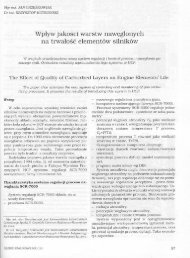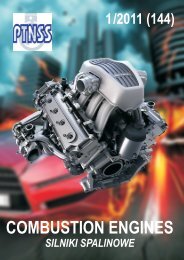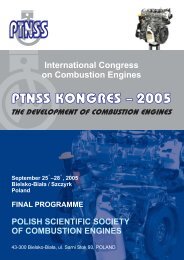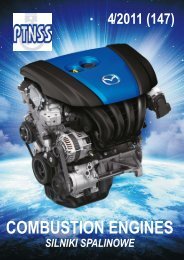You also want an ePaper? Increase the reach of your titles
YUMPU automatically turns print PDFs into web optimized ePapers that Google loves.
Model research of injection of gasoline and E85 into the engine intake pipe<br />
Marcin SZLACHETKA<br />
Mirosław WENDEKER<br />
PTNSS-2012-SS4-406<br />
Model research of injection of gasoline and E85 into the engine intake pipe<br />
The paper describes a simulated injection of PB 95 and E85 to an intake pipe. Integrated with a model of an injector,<br />
a geometric model of an intake pipe of a diameter that corresponds to real dimensions was developed with AVL FIRE<br />
software. Twenty consecutive injections of these types of fuel to the intake pipe were simulated. The studies focused on<br />
how the intensity of fuel film formation was impacted by PB 95 and E85 depending on engine speed and the pressure in<br />
the intake pipe. The paper provides selected results for several engine operating points.<br />
Key words: CFD modeling, fuel film, ethanol<br />
Badania modelowe wtrysku benzyny i paliwa E85 do przewodu dolotowego silnika<br />
W artykule przedstawiono badania modelowe wtrysku benzyny Pb95 oraz paliwa E85 do przewodu dolotowego silnika.<br />
Zastosowano oprogramowanie AVL FIRE. Zbudowano model geometryczny przewodu dolotowego o średnicy odpowiadającej<br />
wymiarami obiektowi rzeczywistemu, wraz z zamontowanym modelem wtryskiwacza. Symulowano 20 kolejnych<br />
wtrysków paliwa do przewodu dolotowego. Badano wpływ zastosowanego paliwa na intensywność powstawania filmu<br />
paliwowego w zależności od prędkości obrotowej silnika oraz ciśnienia w przewodzie dolotowym. Zamieszczono wybrane<br />
wyniki z badań dla kilku punktów pracy silnika.<br />
Słowa kluczowe: modelowanie CFD, film paliwowy, etanol<br />
1. Introduction<br />
Recently, a considerable growth of interest in substitute<br />
and alternative fuels for vehicles has been observed. The<br />
growth of oil prices in world markets forces us to search<br />
for new fuels that could partly or wholly replace the crude<br />
oil based fuels. Recently, a new fuel referred to as Bio85<br />
has appeared in the gas stations. This type of fuel contains<br />
70 ÷ 85% ethanol and is an alternative to oil-derivative fuels.<br />
Application of alcohol-based fuels for fuelling of vehicles<br />
may contribute, among others, to a decrease in the exploitation<br />
of natural resources (a new source of energy) and a decrease<br />
in environmental hazards (lower exhaust emissions).<br />
However, the use of ethanol for fuelling of vehicles requires<br />
adjustment of the injection and engine control system. FFV<br />
(Flexi Fuel Vehicles) adjusted by manufacturers for use of<br />
this type of fuel are already available in the Polish market.<br />
Following an injection of fuel in the intake system of the<br />
engine appears a harmful phenomenon involving sedimentation<br />
of some of the injected fuel on the walls. The fuel creates<br />
a fuel film that gradually evaporates and drips into the cylinder<br />
with a considerable delay. When a fuel other than gasoline<br />
is used the volume and speed of evaporation of the fuel film<br />
changes. This phenomenon has to be compensated for in an<br />
appropriate way (by determining of the coefficients) in the<br />
control algorithm. In order to identify the process of fuel spray<br />
and the formation of the fuel film on the engine intake system<br />
walls for gasoline and E85 simulation tests were performed<br />
with the use of software manufactured by AVL. The influence<br />
of alcohol-based fuel on the intensity of the fuel film formation<br />
depending on the engine speed and the pressure in the intake<br />
pipe was also tested. The distribution and thickness of the fuel<br />
film in the engine intake pipe was also analyzed.<br />
1. Wstęp<br />
Ostatnio obserwuje się znaczący wzrost zainteresowania<br />
zastępczymi i alternatywnymi paliwami do pojazdów<br />
samochodowych. Wzrost cen ropy naftowej na rynkach<br />
światowych skłania do poszukiwania nowych paliw, które<br />
częściowo lub całkowicie zastąpiłyby paliwa pochodzące z<br />
przeróbki ropy naftowej. Obecnie na stacjach benzynowych<br />
pojawiło się nowe paliwo pod nazwą Bio85. Paliwo to zawiera<br />
70 ÷ 85% etanolu i stanowi rozwiązanie alternatywne dla<br />
paliw ropopochodnych. Zastosowanie paliw alkoholowych<br />
do zasilania pojazdów samochodowych może przyczynić<br />
się między innymi do zmniejszenia wykorzystania zasobów<br />
naturalnych (nowe źródło energii) oraz zmniejszenia zagrożenia<br />
środowiska (mniejsza emisja substancji szkodliwych).<br />
Zastosowanie etanolu do zasilania pojazdów wymaga jednak<br />
przystosowania do tego układu wtryskowego oraz układu<br />
sterowania. Na polskim rynku są już dostępne pojazdy FFV<br />
(Flexi Fuel Vehicles) przystosowane przez producentów do<br />
zasilania tego typu paliwem.<br />
Po wtrysku paliwa w układzie dolotowym silnika<br />
powstaje szkodliwe zjawisko osadzania się na ściankach<br />
części wtryśniętego paliwa. Paliwo tworzy tam tzw. film<br />
paliwowy stopniowo parujący i ściekający do cylindra ze<br />
znacznym opóźnieniem. Przy zastosowaniu paliwa o innych<br />
właściwościach niż benzyna występuje zmiana wielkości i<br />
szybkości parowania filmu paliwowego. Zjawisko to musi<br />
być kompensowane w odpowiedni sposób (wyznaczonymi<br />
współczynnikami) w algorytmie sterującym. W celu identyfikacji<br />
procesu tworzenia strugi paliwa oraz powstawania<br />
filmu paliwowego na ściankach układu dolotowego silnika<br />
dla benzyny oraz E85 przeprowadzono badania symulacyjne<br />
z wykorzystaniem oprogramowania firmy AVL. Badano<br />
<strong>COMBUSTION</strong> <strong>ENGINES</strong>, No. 4/2012 (151)<br />
55












